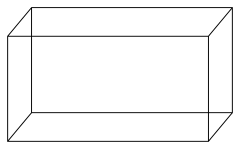Cuboid
In geometry, a cuboid is a convex polyhedron bounded by six quadrilateral faces, whose polyhedral graph is the same as that of a cube. While mathematical literature refers to any such polyhedron as a cuboid,[1] other sources use "cuboid" to refer to a shape of this type in which each of the faces is a rectangle (and so each pair of adjacent faces meets in a right angle); this more restrictive type of cuboid is also known as a rectangular cuboid, right cuboid, rectangular box, rectangular hexahedron, right rectangular prism, or rectangular parallelepiped.[2]
General cuboids
By Euler's formula the numbers of faces F, of vertices V, and of edges E of any convex polyhedron are related by the formula F + V = E + 2. In the case of a cuboid this gives 6 + 8 = 12 + 2; that is, like a cube, a cuboid has 6 faces, 8 vertices, and 12 edges. Along with the rectangular cuboids, any parallelepiped is a cuboid of this type, as is a square frustum (the shape formed by truncation of the apex of a square pyramid).
Rectangular cuboid
| Rectangular cuboid | |
|---|---|
 | |
| Type | Prism Plesiohedron |
| Faces | 6 rectangles |
| Edges | 12 |
| Vertices | 8 |
| Symmetry group | D2h, [2,2], (*222), order 8 |
| Schläfli symbol | { } × { } × { } |
| Coxeter diagram | |
| Dual polyhedron | Rectangular fusil |
| Properties | convex, zonohedron, isogonal |
In a rectangular cuboid, all angles are right angles, and opposite faces of a cuboid are equal. By definition this makes it a right rectangular prism, and the terms rectangular parallelepiped or orthogonal parallelepiped are also used to designate this polyhedron. The terms "rectangular prism" and "oblong prism", however, are ambiguous, since they do not specify all angles.
The square cuboid, square box, or right square prism (also ambiguously called square prism) is a special case of the cuboid in which at least two faces are squares. It has Schläfli symbol {4} × { }, and its symmetry is doubled from [2,2] to [4,2], order 16.
The cube is a special case of the square cuboid in which all six faces are squares. It has Schläfli symbol {4,3}, and its symmetry is raised from [2,2], to [4,3], order 48.
If the dimensions of a rectangular cuboid are a, b and c, then its volume is abc and its surface area is 2(ab + ac + bc).
The length of the space diagonal is
Cuboid shapes are often used for boxes, cupboards, rooms, buildings, containers, cabinets, books, a sturdy computer chassis, printing devices, electronic calling touchscreen devices, washing and drying machines, etc. Cuboids are among those solids that can tessellate 3-dimensional space. The shape is fairly versatile in being able to contain multiple smaller cuboids, e.g. sugar cubes in a box, boxes in a cupboard, cupboards in a room, and rooms in a building.
A cuboid with integer edges as well as integer face diagonals is called an Euler brick, for example with sides 44, 117 and 240. A perfect cuboid is an Euler brick whose space diagonal is also an integer. It is currently unknown whether a perfect cuboid actually exists.
Nets
The number of different nets for a simple cube is 11, however this number increases significantly to 54 for a rectangular cuboid of 3 different lengths.[3]
See also
References
- Robertson, Stewart Alexander (1984). Polytopes and Symmetry. Cambridge University Press. p. 75. ISBN 9780521277396.
- Dupuis, Nathan Fellowes (1893). Elements of Synthetic Solid Geometry. Macmillan. p. 53. Retrieved December 1, 2018.
- Steward, Don (May 24, 2013). "nets of a cuboid". Retrieved December 1, 2018.
External links
| Wikimedia Commons has media related to Hexahedra with cube topology. |
| Wikimedia Commons has media related to Rectangular cuboids. |
- Weisstein, Eric W. "Cuboid". MathWorld.
- Rectangular prism and cuboid Paper models and pictures